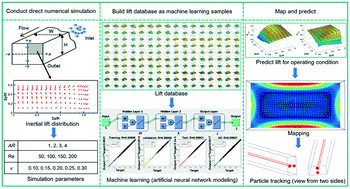Machine learning assisted fast prediction of inertial lift in microchannels†
Abstract
Inertial effect has been extensively used in manipulating both engineered particles and biocolloids in microfluidic platforms. The design of inertial microfluidic devices largely relies on precise prediction of particle migration that is determined by the inertial lift acting on the particle. In spite of being the only means to accurately obtain the lift forces, direct numerical simulation (DNS) often consumes high computational cost and even becomes impractical when applied to microchannels with complex geometries. Herein, we proposed a fast numerical algorithm in conjunction with machine learning techniques for the analysis and design of inertial microfluidic devices. A database of inertial lift forces was first generated by conducting DNS over a wide range of operating parameters in straight microchannels with three types of cross-sectional shapes, including rectangular, triangular and semicircular shapes. A machine learning assisted model was then developed to gain the inertial lift distribution, by simply specifying the cross-sectional shape, Reynolds number and particle blockage ratio. The resultant inertial lift was integrated into the Lagrangian tracking method to quickly predict the particle trajectories in two types of microchannels in practical devices and yield good agreement with experimental observations. Our database and the associated codes allow researchers to expedite the development of the inertial microfluidic devices for particle manipulation.



 Please wait while we load your content...
Please wait while we load your content...